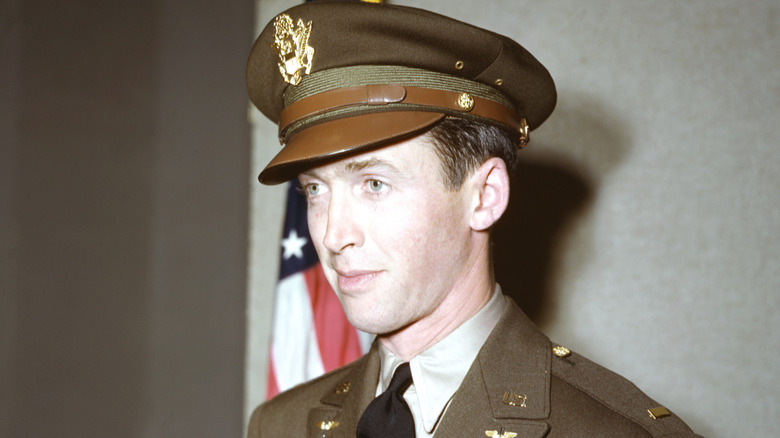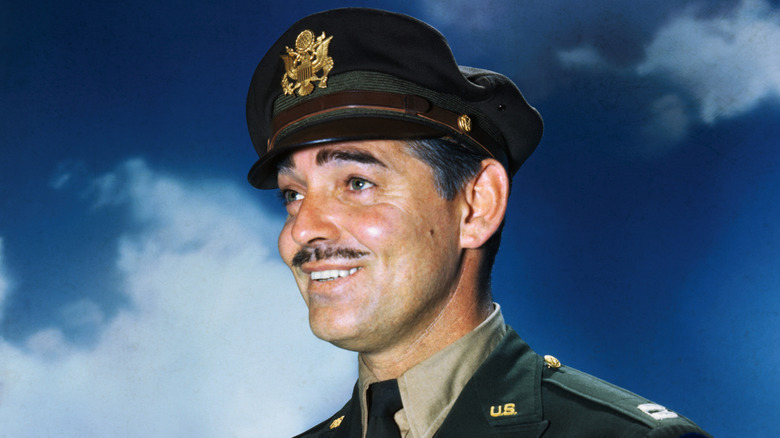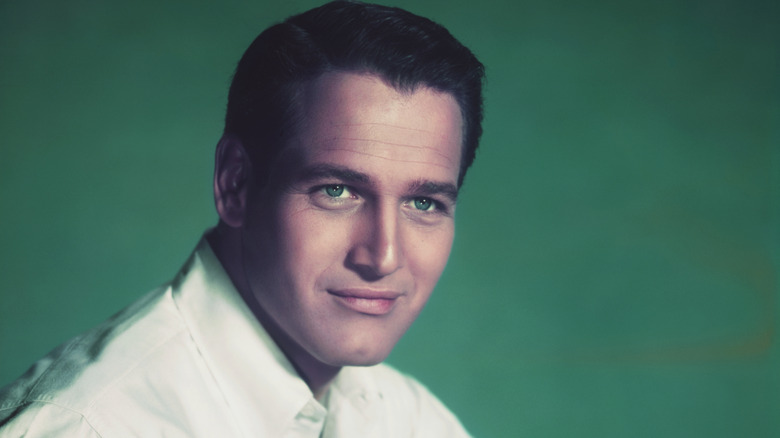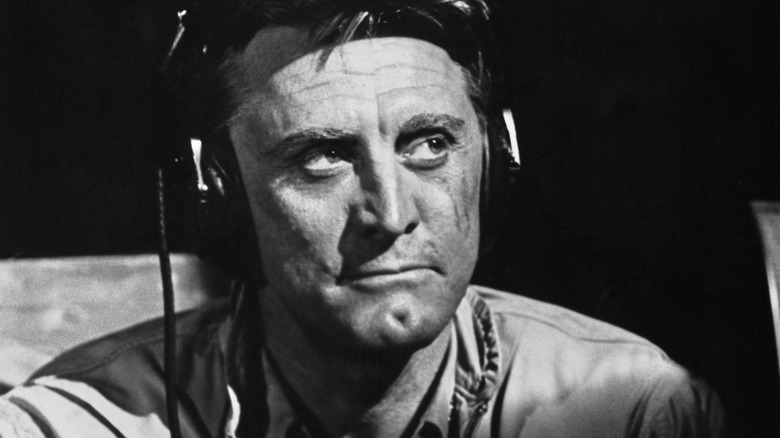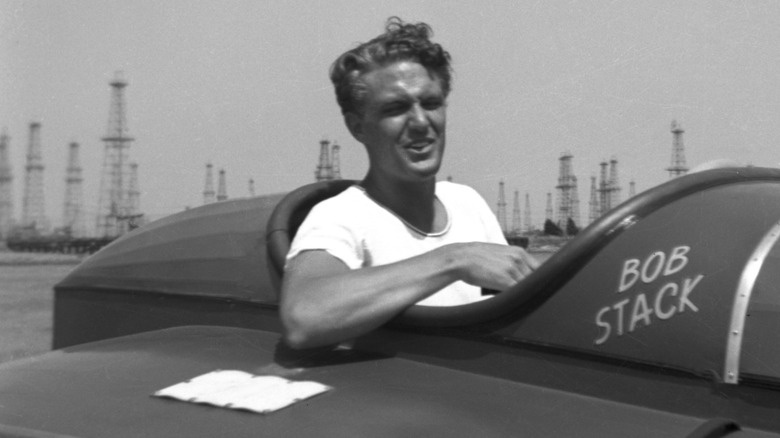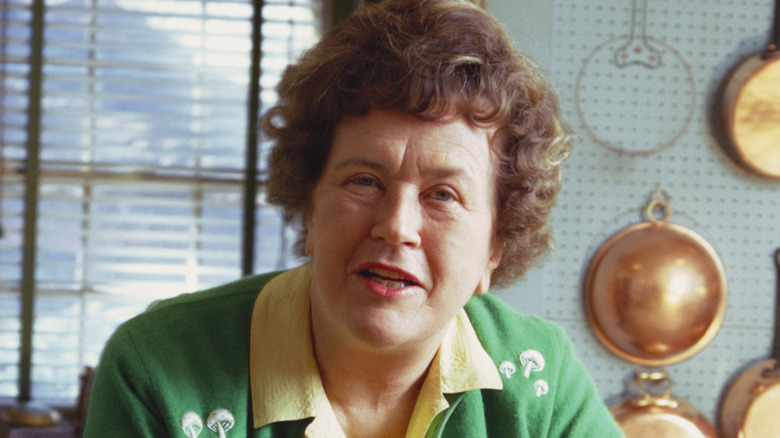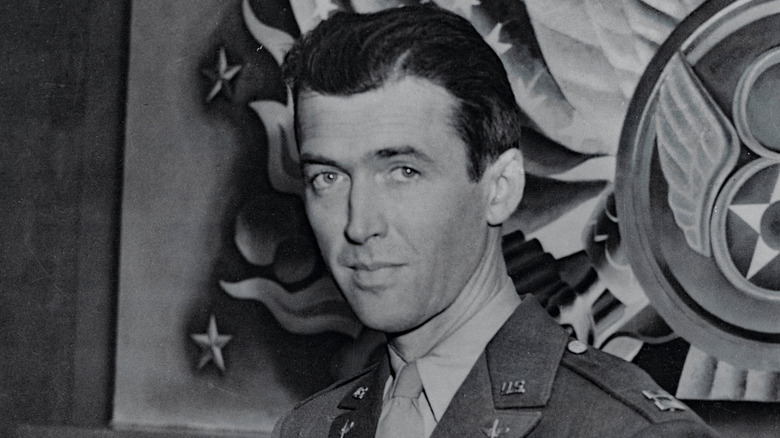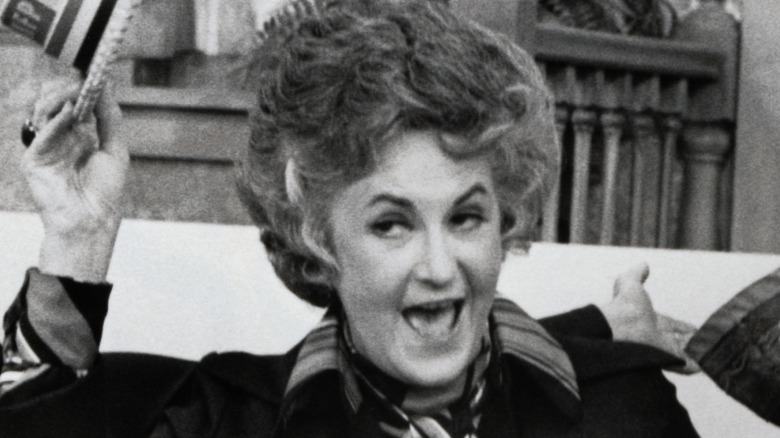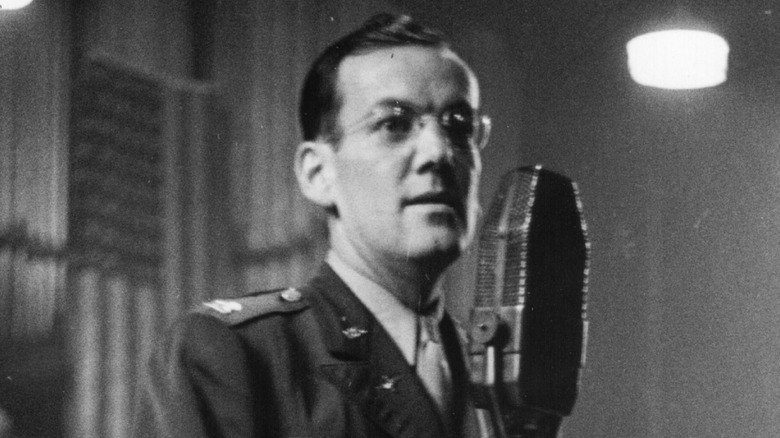Famous People Who Actually Served During WWII
Most of the world's population wasn't alive when World War II was fought, and so it's easy to lose sight of the magnitude of the conflict, especially because a lot of things about World War II just don't make sense. Not only did it last for the better part of a decade, but the most important battles of World War II were waged all over the globe. Many famous and lesser known heroes of World War II emerged as the Allied forces, led by the U.S., the U.K., and Russia, fought the Axis powers of imperial Japan, fascist Italy, and Nazi Germany. A lot of messed-up things happened during World War II, and it was the defining and traumatizing event of a generation.
About 16 million people from the U.S. alone participated in the war effort, either on the front lines or working for the military or an intelligence agency. It took the labors of people from all walks of life to defeat the enemy, even celebrities. Some of the most famous and beloved musicians, actors, and stars of the mid-20th century all served their countries, and helped the Allies win World War II.
Clark Gable
Clark Gable, the Oscar-winning star of "It Happened One Night" and "Gone with the Wind," turned 40 years old in 1941, the year that the United States joined World War II. Too old for the draft, the U.S. government appointed Gable to be the leader of the Hollywood Victory Committee, an organization that used stateside celebrities and the machinery of the entertainment industry to boost morale and promote war bonds. Gable hired his wife, actor Carole Lombard, to market war bonds, but after a promotional event in Indiana in January 1942, her plane crashed into a mountain in Nevada.
Gable, distraught and looking to take on a more active role in the war, sent a telegram to President Franklin D. Roosevelt requesting a spot on the front lines. Rejected, he signed up for the Army Air Force and enrolled in officer school and aerial gunnery school. Dispatched to the 351st Bomb Group in England, Gable's assignment was to make educational films to show gunners what the job would entail.
He didn't need to, but Gable embedded himself and a camera on five Allied bombing raids on Germany in order to get instructional combat material. In one such trip, Gable sustained retaliatory gunfire, when a shell struck his boot and grazed his head. By the time of his 1944 discharge, Gable had ascended to the rank of major.
Paul Newman
Just after he graduated high school in Ohio in 1943, Paul Newman signed up for wartime service in the U.S. Navy. He trained in an aviation program at Yale University, eager to be a naval pilot. However, his physical examination uncovered color blindness, so Newman went to boot camp instead and was instructed in being an airborne rear-seat radio operator and a gunner on torpedo bomber craft.
In 1944, Aviation Radioman Third Class Newman was stationed in Hawaii to bring relief to torpedo squadrons that had been decimated after nearly three years of warfare. Over this two-year stint in the Navy, Newman was used mainly in training missions for earmarked pilots and combat air crew staff, particularly in helping them learn how to land on aircraft carriers. Newman was aboard just such a vessel off the coast of Japan when it was bombed by a Japanese pilot, and another, also off the coast of Japan, when the U.S. military dropped the first atomic bomb on Hiroshima.
Kirk Douglas
Issur Danielovitch Demsky had recently changed his name to Kirk Douglas with an eye toward a career in theater in 1941, when the Japanese military bombing of Pearl Harbor prompted a wave of young actors to join stateside operations to make training films or troop-entertainment brigades. That's what his friends did, but not Douglas, who answered a call to fight. "I felt a wave of patriotism and a wave of Jewishness about what was happening in Europe with Hitler," Douglas told Playbill (via Navy Times).
After he was unable to pass a dexterity test to become an Army pilot over Europe, Douglas joined the Navy and was stationed in the Pacific theater, serving with the American-led combat operations against Japan. Ensign Douglas received training in anti-submarine warfare communications and gunnery activities, and worked on a craft that hunted down Japanese submarines. During one such mission onboard PC-1139, misfired artillery blew up and sent the sub airborne. Douglas survived and recuperated from serious injuries to his abdomen at a Navy hospital in San Diego, where doctors diagnosed him with chronic dysentery, which in turn led to his discharge in 1944.
Alec Guinness
Once best known for his Oscar-winning role in the harrowing classic war movie "The Bridge on the River Kwai," Alec Guinness is forever associated with his Oscar-nominated work as Obi-Wan Kenobi in "Star Wars," a big role that the actor actually hated. Guinness made his film acting debut in earnest in 1946's "Great Expectations," produced just after the actor served in the United Kingdom's Royal Navy.
Joining in 1939, Guinness was made an officer in 1942, and for the rest of that year he mainly conducted exercises and transports until he was needed for bigger missions. In 1943, the HMS LCM24, under the command of Sub-Lieutenant Guinness, was among the warships picked to execute Operation Husky, the Allied invasion of the Axis-controlled Italian island of Sicily. On the way to the set place and time, Guinness' ship picked up 200 men from the Royal Highland Regiment, and in doing so didn't get the message that the invasion had been delayed by an hour. Thus, Guinness was the first to arrive for Operation Husky, and he and his sailors sustained heavy artillery from land and sea.
Robert Stack
In the 1950s and 1960s, Robert Stack played real-life federal agent Eliot Ness on "The Untouchables," and became iconic to another generation in the 1980s with a role in "Airplane!" and hosting the spooky "Unsolved Mysteries." Stack's first blush with fame came as an athlete. A skilled and accomplished shooter, he joined the All-American Skeet Team at the age of 16, eventually setting a couple of world records and winning a national championship.
In 1942, inspired in part by the death of his "To Be or Not to Be" costar Carole Lombard, Stack interrupted a burgeoning film career to enlist in the U.S. Navy. His superiors made Stack an ensign, and logically, an aerial gunnery instructor, teaching draftees and enlistees how to shoot down other planes from their own as well as in anti-aircraft combat. Near the time World War II concluded in 1945, Stack was discharged with a promotion to lieutenant.
Julia Child
One of the first people to make cooking instructional television and still one of the most famous TV chefs, Julia Child brought top-notch cooking to the masses with her PBS series "The French Chef" and bestselling cookbook "Mastering the Art of French Cooking." With U.S. involvement in World War II looming in September 1941, Child went to work for the American Red Cross in Pasadena, and then attempted to join up with military-adjacent agencies, the Women's Army Corps and the Women Accepted for Volunteer Emergency Services.
Child stood 6 feet 2 inches and was deemed too tall for both organizations, so in 1942 she headed to Washington, D.C., for a job as a typist in the Office of War Information. She then became a junior research assistant with the Secret Intelligence operation in the Office of Strategic Services, precursor of the Central Intelligence Agency. One of Child's main tasks was to maintain files on officers working around the world.
Child wanted to work closer to the action, and in 1944 she worked for intelligence operations in Ceylon (now Sri Lanka) and China. She also served in the OSS Emergency Sea Rescue Equipment Section, and with two officers, helped develop cutting-edge spy technology for military use. The future TV food personality was instrumental in making a shark repellent, which was used to cover underwater explosives to ensure they made their way to targeted Nazi U-boats.
Jimmy Stewart
One of the most bankable and acclaimed film stars of the 1930s and early 1940s, Jimmy Stewart starred in classics like "The Shop Around the Corner," "Mr. Smith Goes to Washington," and "The Philadelphia Story" (for which he won an Academy Award), before taking five years off.
Between 1941 and 1945, Stewart was in the Air Force. Before the U.S. had technically entered World War II, Stewart was drafted and sent to an Army Air Corps base for training. He used his nine months to take courses to receive a special commission, and his 400 hours of flight time as a small aircraft pilot informed the military's decision to let him take flight classes and fly fighter planes. In 1943, Stewart was dispatched to Europe to fight as the Commanding Officer of the 703rd Bomb Squadron.
Later named Operations Officer of the 453rd Bomb Group and chief of staff of a combat unit, Stewart flew 20 anti-Nazi combat flights. Remaining a member of the Air Force Reserves after the end of World War II, Stewart was promoted to Brigadier General in 1959.
Ted Williams
Ted Williams entered Major League Baseball in 1939 with the Boston Red Sox and quickly established himself as one of the all-time greats. Following three all-star seasons in which he led the league in on-base percentage three times and racked up an above .400 batting average — the last hitter in history to do so — Williams took a three-year break from baseball. Before America joined combat activities in 1941, Williams was rejected from service on account of being his mother's sole provider. Following the Pearl Harbor attacks, Williams pleaded with the draft board to let him fight, and he was allowed to enlist in the Navy after the conclusion of the 1942 baseball season.
Williams had his sights set on being a Naval Aviator, and he attended ground, preflight, and flight school. In 1944, he earned his commission as a second lieutenant in the Marines and, after more education, trained would-be combat pilots in Florida and Hawaii. In the summer of 1945, Williams waited for the chance to fly and attack as a combat pilot replacement, but the war ended before he got the call.
Mel Brooks
As an actor, writer, songwriter, and director, Mel Brooks was an instrumental figure in screen comedy, responsible for films like "The Producers," "Blazing Saddles," and "Young Frankenstein." He often took pointed shots at history and society's most hateful villains, particularly Adolf Hitler. Before he made any movies, Brooks — aka Melvin Kaminsky — did what he could to fight the Nazis.
Drafted in 1944, Brooks scored exceptionally high on the entrance test, earning him a spot in the Army Specialized Training Program for instruction in combat engineering. After basic training, Brooks was dispatched to France and Belgium, acting as a forward artillery observer in the 78th Infantry Division. Later a member of the 1104th Engineer Combat Group, Brooks was on the very front lines in the early moments of the Battle of the Bulge. His job was to clear away the landmines placed by Nazi forces to allow for safer passage by the Allies. On five different occasions during his year-plus service, Brooks faced close-up combat situations with German troops. In April 1945, the war ended while Brooks had been working on a spying project in Northern Germany.
Bea Arthur
In February 1943, the last gendered holdout branch in the Armed Forces opened its ranks to women, when the Marine Corps announced it was actively recruiting for the Women's Reservists division. The aim of the program was to move as many men in the employ of the Marines to combat positions, and bring in women to perform support services. Around 20,000 women became Marines over the last two years of World War II, including Bernice Frankel, who'd later take on the stage name of Bea Arthur as a star of Broadway and TV's "Maude" and "The Golden Girls."
Already working as an air-raid warden in a civilian capacity, 20-year-old Frankel/Arthur signed up for the Marines five days after it started recruiting women. Trained at the Women Reservists school in New York, Arthur was stationed at the U.S. Marine Corps Air Station in North Carolina and worked as a driver and dispatcher. When discharged in the fall of 1945, Arthur had made it to the rank of Staff Sergeant.
Tony Bennett
One of the great crooners with a career that lasted into his nineties, the life of Tony Bennett included some seriously tragic details. In 1944, A few months after his 18th birthday, Bennett was drafted into the U.S. Army and received his infantry rifleman training. Then he was sent to France to serve in the G Company, 7th Army, 63rd Infantry Division. The unit had fought in the Battle of the Bulge and had incurred such significant losses that it needed a wave of fresh troops to round out its numbers.
Bennett's introduction to combat came at 4 a.m. when the very high-ranking General George S. Patton awoke Bennett and his fellow new troops, proclaiming, as Bennett recalled in "The Good Life" (via Military.com), "Now listen up! Forget your mothers and everything else you've ever known!" Immediately, Bennett was building foxholes in frozen ground to provide protection from German gunners. On his first night, Bennett barely avoided a likely deadly hit. "The front was a front-row seat in hell," he wrote. "It was an absolutely terrifying spectacle."
In the spring of 1945, Bennett's group entered Germany and captured small towns in Germany, securing them one home at a time. Bennett's last wartime act was to help liberate a Nazi concentration camp outside of Landsberg. "We immediately got food and water to the survivors, but they had been brutalized for so long, they couldn't believe that we were there to help them and not to kill them," he wrote.
Glenn Miller
Before rock stars or rock was a thing, the most famous and fussed over musicians were bandleaders. Leading big orchestras and dance bands, conductors, composers, and arrangers like Glenn Miller ruled the pop chart. The Glenn Miller Orchestra scored 25 big hits in 1939 alone, including big band standards like "In the Mood" and "Sunrise Serenade." Miller and his small army of musicians kept up morale throughout the early years of World War II, churning out happy and jaunty hits, until Miller decided to join up with the actual army.
By then in his late 30s and too old to be drafted or to enlist in the Navy, Miller headed to the Army's Air Force. The Air Force utilized Miller's rare and unique skills, allowing him to form and lead the 418th Army Air Forces Band. Made up of soldiers, the band provided solace and entertainment for both the troops who played in the band and its audiences of young men, stationed thousands of miles from home and fighting in a frightening war. Miller and his band also played frequently on troop-centered radio networks.
In December 1944, Miller's plane, en route to a performance in Paris, went down over the English Channel and was never recovered.
Yogi Berra
Perhaps best known for his many malapropisms ("It ain't over til it's over," for example), Yogi Berra was an excellent baseball player, too. Over 18 seasons with the New York Yankees, the catcher won 10 World Series titles and was named the American League's most valuable player three times. He made his big-league debut in 1946, three years after he'd first played in the minor leagues, because he'd been conscripted into military service during World War II.
Enrolling in the U.S. Navy in 1943, 18-year-old Berra actively joined a top-secret operation, later revealed to be service on a rocket-and-machine-gun-armed craft on its way to be among the first vehicles in the pivotal June 1944 Allied invasion of Nazi-held Normandy, an event better known as D-Day. Berra was one of six men on board tasked with approaching Normandy and attacking German machine-gunners to clear a path for the foot soldiers storming the beach. Surviving the chaotic and deadly military endeavor, Berra took on another similar mission in late 1944, participating in the liberation of southern France.
